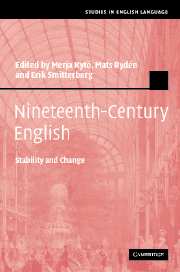Book contents
- Frontmatter
- Contents
- List of plates
- List of figures
- List of tables
- List of contributors
- Acknowledgements
- Introduction: Exploring nineteenth-century English – past and present perspectives
- 1 Modifiers describing women and men in nineteenth-century English
- 2 Words in English Record Office documents of the early 1800s
- 3 The subjunctive in adverbial clauses in nineteenth-century English
- 4 The passive in nineteenth-century scientific writing
- 5 Relativizers in nineteenth-century English
- 6 Anaphoric reference in the nineteenth century: that/those + of constructions
- 7 Adjective comparison in nineteenth-century English
- 8 Nonfinite complement clauses in the nineteenth century: the case of remember
- 9 The in -ing construction in British English, 1800–2000
- 10 Partitive constructions in nineteenth-century English
- Appendix
- References
- Name index
- Subject index
8 - Nonfinite complement clauses in the nineteenth century: the case of remember
Published online by Cambridge University Press: 22 September 2009
- Frontmatter
- Contents
- List of plates
- List of figures
- List of tables
- List of contributors
- Acknowledgements
- Introduction: Exploring nineteenth-century English – past and present perspectives
- 1 Modifiers describing women and men in nineteenth-century English
- 2 Words in English Record Office documents of the early 1800s
- 3 The subjunctive in adverbial clauses in nineteenth-century English
- 4 The passive in nineteenth-century scientific writing
- 5 Relativizers in nineteenth-century English
- 6 Anaphoric reference in the nineteenth century: that/those + of constructions
- 7 Adjective comparison in nineteenth-century English
- 8 Nonfinite complement clauses in the nineteenth century: the case of remember
- 9 The in -ing construction in British English, 1800–2000
- 10 Partitive constructions in nineteenth-century English
- Appendix
- References
- Name index
- Subject index
Summary
Introduction
The vast and complex system of nonfinite clausal complements in Present-day English has attracted scholarly attention from syntacticians of virtually every theoretical persuasion. While not understood in every detail, the major outlines of present-day usage, including regional and stylistic variation, have been documented and analysed satisfactorily. What is covered far less well, however, is the history of this complicated system, in particular in its more recent stages since c. 1800. This is all the more surprising since in contrast to word order or the forms of questions and negation, where after rapid developments during the Early Modern English period a degree of stabilization set in in the early nineteenth century, there is every indication that usage of infinitives, participles and gerunds has continued changing with unabated vigour also in the past two centuries.
In two related studies (Mair 2002a, 2002b), I have shown this to be the case for (a) the use of gerunds and infinitives with the verbs begin and start, (b) the variable use of from with gerunds dependent on prevent, and (c) the use of bare vs to-infinitives with help. In the present paper I propose to look at the complementation of remember; as in the companion studies, the OED quotation base on CD-ROM will be used as a ‘corpus’, making possible the study of change and variability which – for lack of sufficient data – cannot be investigated on the basis of smaller standard historical corpora such as ARCHER.
- Type
- Chapter
- Information
- Nineteenth-Century EnglishStability and Change, pp. 215 - 228Publisher: Cambridge University PressPrint publication year: 2006
- 2
- Cited by

